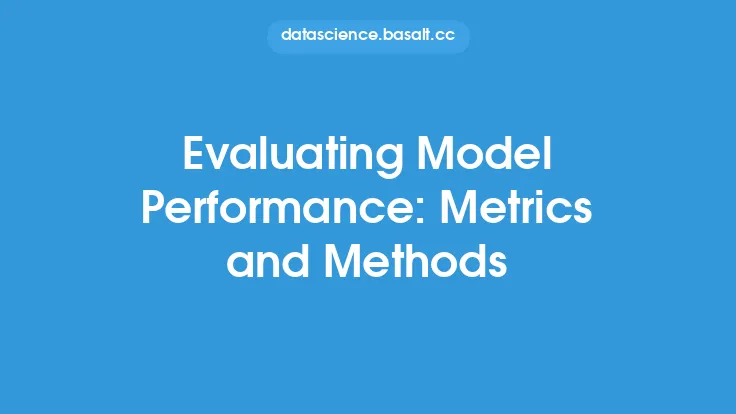Machine learning models have become increasingly complex and powerful, allowing them to make accurate predictions and drive business decisions. However, this complexity comes at a cost, making it challenging to understand how the models arrive at their predictions. Model interpretability methods aim to address this issue by providing insights into the relationships between the input features and the predicted outcomes. In this article, we will delve into the world of model interpretability, exploring various techniques that can help uncover the underlying mechanics of machine learning models.
Introduction to Model Interpretability Methods
Model interpretability methods can be broadly categorized into two types: model-specific and model-agnostic. Model-specific methods are designed for specific machine learning algorithms, such as decision trees or neural networks, and provide detailed insights into the model's internal workings. Model-agnostic methods, on the other hand, can be applied to any machine learning model, regardless of its type or complexity. These methods focus on analyzing the relationships between the input features and the predicted outcomes, without requiring access to the model's internal structure.
Feature Importance
One of the most widely used model interpretability methods is feature importance. Feature importance assigns a score to each input feature, indicating its relative contribution to the predicted outcome. The scores can be calculated using various techniques, such as permutation importance, Gini importance, or SHAP values. Permutation importance, for example, works by randomly permuting the values of a single feature and measuring the decrease in model performance. The feature with the largest decrease in performance is considered the most important. Feature importance can be used to identify the most relevant features in a dataset, allowing practitioners to refine their models and improve their performance.
Partial Dependence Plots
Partial dependence plots (PDPs) are another powerful model interpretability method. PDPs visualize the relationship between a specific feature and the predicted outcome, while controlling for the effects of all other features. The plot shows the average predicted outcome for a range of values of the selected feature, providing insights into the feature's marginal effect on the outcome. PDPs can be used to identify non-linear relationships between features and outcomes, as well as interactions between features. For example, a PDP might show that the relationship between age and income is non-linear, with income increasing rapidly between the ages of 25 and 40, but leveling off after age 50.
SHAP Values
SHAP (SHapley Additive exPlanations) values are a technique for assigning a value to each feature for a specific prediction, indicating its contribution to the outcome. SHAP values are based on the concept of Shapley values, which are used in game theory to allocate the total value of a coalition among its members. In the context of model interpretability, SHAP values can be used to explain the contribution of each feature to a specific prediction. For example, a SHAP value might show that the feature "age" contributed 0.2 to the predicted income of $50,000, while the feature "education" contributed 0.5.
Local Interpretable Model-agnostic Explanations (LIME)
LIME is a technique for generating local, interpretable models that approximate the behavior of a complex machine learning model. LIME works by creating a dataset of perturbed samples around a specific instance, and then training an interpretable model (such as a linear model or a decision tree) on this dataset. The interpretable model is then used to explain the predictions of the complex model for the specific instance. LIME can be used to generate explanations for individual predictions, providing insights into the relationships between the input features and the predicted outcomes.
Model Interpretability for Deep Learning Models
Deep learning models, such as neural networks, pose unique challenges for model interpretability. The complex, non-linear relationships between the input features and the predicted outcomes make it difficult to understand how the models arrive at their predictions. Techniques such as saliency maps, feature importance, and SHAP values can be used to provide insights into the behavior of deep learning models. Saliency maps, for example, highlight the input features that are most relevant to the predicted outcome, while feature importance and SHAP values provide quantitative measures of the features' contributions.
Model Interpretability for Tree-Based Models
Tree-based models, such as decision trees and random forests, are often considered more interpretable than deep learning models. The tree structure provides a clear, visual representation of the relationships between the input features and the predicted outcomes. Techniques such as feature importance and partial dependence plots can be used to provide additional insights into the behavior of tree-based models. For example, a feature importance plot might show that the feature "age" is the most important feature in a decision tree, while a PDP might show the non-linear relationship between "age" and the predicted outcome.
Conclusion
Model interpretability methods provide a powerful toolkit for understanding the behavior of machine learning models. From feature importance to partial dependence plots, these techniques can help uncover the relationships between the input features and the predicted outcomes. By applying these methods, practitioners can refine their models, improve their performance, and build trust in their predictions. As machine learning continues to play an increasingly important role in business and society, the importance of model interpretability will only continue to grow. By providing insights into the inner workings of complex models, model interpretability methods can help ensure that machine learning is used responsibly and effectively.





